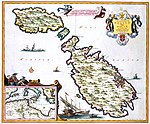
Back Geskiedenis van Malta Afrikaans تاريخ مالطا Arabic تاريخ د مالطا ARY Historia de Malta AST Malta tarixi Azerbaijani Мальта тарихы Bashkir История на Малта Bulgarian Història de Malta Catalan Dějiny Malty Czech Maltas historie Danish
| History of Malta |
|---|
 |
|
|
This article needs additional citations for verification. (October 2023) |
Malta has been inhabited since 5900 BC.[1][2] The first inhabitants were farmers; their agricultural methods degraded the soil until the islands became uninhabitable. The islands were repopulated around 3850 BC by a civilization that at its peak built the Megalithic Temples, which today are among the oldest surviving buildings in the world. Their civilization collapsed in around 2350 BC; the islands were repopulated by Bronze Age warriors soon afterwards.
Malta's prehistory ends in around 700 BC, when the islands were colonized by the Phoenicians. They ruled the islands until they fell in 218 BC to the Roman Republic. The island was acquired by the Eastern Romans or Byzantines in the 6th century AD, who were expelled by Aghlabids following a siege in 870 AD. Malta may have been sparsely populated for a few centuries until being repopulated by Arabs in the 11th century. The islands were invaded by the Norman County of Sicily in 1091, and a gradual Christianization of the islands followed. At this point, the islands became part of the Kingdom of Sicily and were dominated by successive feudal rulers, including the Swabians, the Aragonese, and eventually the Spanish. The islands were given to the Order of St. John in 1530, which ruled them as a vassal state of Sicily. In 1565, the Ottoman Empire attempted to take the islands in the Great Siege of Malta, but the invasion was repelled. The Order continued to rule Malta for over two centuries, and this period was characterized by a flourishing of the arts and architecture and an overall improvement in the social order [citation needed]. The Order was expelled after the French First Republic invaded the islands in 1798, marking the beginning of the French occupation of Malta.
After a few months of French rule, the Maltese rebelled and the French were expelled in 1800. Malta became a British protectorate, becoming a de facto colony in 1813. The islands became an important naval base for the British, serving as the headquarters of the Mediterranean Fleet. During the last quarter of the 19th century, there were advancements in technology and finance. In subsequent years, the Anglo-Egyptian Bank was established in 1882 and the Malta Railway began operating in 1883. In 1921, London granted self-government to Malta. This resulted in the establishment of a bicameral parliament consisting of a Senate (which was later eliminated in 1949) and an elected Legislative Assembly. The Crown Colony of Malta was self-governing in 1921–1933, 1947–1958, and 1962–1964.
During World War II British forces in Malta were heavily attacked by Italian and German air power, but the British held firm. In 1942 the island was awarded the George Cross, which today appears on Malta's flag and coat of arms.
In 1964 Malta became an independent Commonwealth realm known as the State of Malta, and in 1974 it became a republic while remaining in the Commonwealth. Since 2004 the country has been a member state of the European Union.
- ^ Farrugia, Claire (19 March 2018) [2018-03-18]. "First inhabitants arrived 700 years earlier than thought". Times of Malta. Retrieved 25 March 2020.
- ^ Cite error: The named reference
TimesMalta-2018-03-16was invoked but never defined (see the help page).